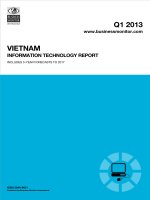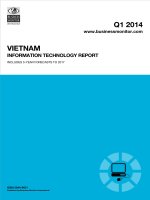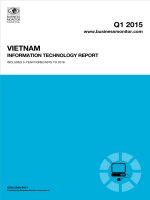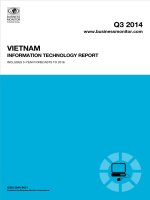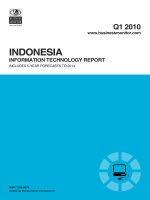United states information technology report q1 2014
Bạn đang xem bản rút gọn của tài liệu. Xem và tải ngay bản đầy đủ của tài liệu tại đây (534.54 KB, 101 trang )
Q1 2014
www.businessmonitor.com
UNITED STATES
INFORMATION TECHNOLOGY REPORT
INCLUDES 5-YEAR FORECASTS TO 2017
ISSN 2042-4205
Published by:Business Monitor International
United States Information
Technology Report Q1 2014
INCLUDES 5-YEAR FORECASTS TO 2017
Part of BMI’s Industry Report & Forecasts Series
Published by: Business Monitor International
Copy deadline: December 2013
Business Monitor International
Senator House
85 Queen Victoria Street
London
EC4V 4AB
United Kingdom
Tel: +44 (0) 20 7248 0468
Fax: +44 (0) 20 7248 0467
Email:
Web:
© 2013 Business Monitor International
All rights reserved.
All information contained in this publication is
copyrighted in the name of Business Monitor
International, and as such no part of this
publication may be reproduced, repackaged,
redistributed, resold in whole or in any part, or used
in any form or by any means graphic, electronic or
mechanical, including photocopying, recording,
taping, or by information storage or retrieval, or by
any other means, without the express written consent
of the publisher.
DISCLAIMER
All information contained in this publication has been researched and compiled from sources believed to be accurate and reliable at the time of
publishing. However, in view of the natural scope for human and/or mechanical error, either at source or during production, Business Monitor
International accepts no liability whatsoever for any loss or damage resulting from errors, inaccuracies or omissions affecting any part of the
publication. All information is provided without warranty, and Business Monitor International makes no representation of warranty of any kind as
to the accuracy or completeness of any information hereto contained.
CONTENTS
BMI Industry View 7
SWOT 9
IT SWOT 9
Wireline SWOT 11
Political 13
Economic 14
Business Environment 15
Industry Forecast 16
Table: US IT Industry - Historical Data And Forecasts (US$mn unless otherwise stated) 16
Broadband 21
Table: Telecoms Sector - Internet - Historical Data & Forecasts 21
Macroeconomic Forecasts 23
Economic Activity 23
Table: US - GDP By Expenditure 30
Industry Risk Reward Ratings 32
Table: Americas IT Risk/Reward Ratings, Q1 2014 34
Market Overview 35
Hardware 35
Software 43
Services 48
Industry Trends And Developments 51
Regulatory Development 55
Table: IT Regulatory Authorities 55
Competitive Landscape 57
Local Companies 57
Table: CA Technologies 57
Table: Splunk 58
Table: Symantec 58
Table: EMC Corporation 59
Company Profile 60
Hewlett-Packard 60
Dell 67
Microsoft Corporation 73
IBM 81
Table: IBM Acquisitions, 2012 (Total Value, US$3.964bn) 83
United States Information Technology Report Q1 2014
© Business Monitor International Page 4
Regional Overview 88
Demographic Forecast 92
Demographic Outlook 92
Table: The United States' Population By Age Group, 1990-2020 ('000) 93
Table: The United States' Population By Age Group, 1990-2020 (% of total) 94
Table: The United States' Key Population Ratios, 1990-2020 95
Table: The United States' Rural And Urban Population, 1990-2020 95
Methodology 96
Industry Forecast Methodology 96
Sources 97
Risk/Reward Rating Methodology 98
Table: It Risk Reward Rating Indicators 99
Table: Weighting Of Components 100
United States Information Technology Report Q1 2014
© Business Monitor International Page 5
BMI Industry View
BMI View: The outlook for US IT spending remains strong relative to the majority of developed markets
over the medium term as a result of stronger economic performance and a greater appetite from enterprises
for the latest products and solutions. Cloud computing, real-time enterprise software, security and Big Data
are all areas of spending in which we expect to see rapid growth. We also expect continued demand growth
for tablets in the retail market, however there is downside risk as desktop and notebook sales continue to be
squeezed. There is also downside to this outlook from the potential for deeper fiscal retrenchment to hit
government IT spending, the NSA PRISM scandal to disrupt the cloud computing market and a downturn in
the wider economy. Total spending is expected to reach US$588bn in 2013, up 6.6% from 2012, and grow
at a CAGR of 5.1% to 2017.
Headline Expenditure Projections
■
Computer Hardware Sales: US$144bn in 2012 to US$152bn in 2013, an increase of 4.7%. Booming
tablet sales are driving growth while desktop and notebook sales are under pressure from cannibalisation.
■
Software Sales: US$161bn in 2012 to US$173bn in 2013, an increase of 7.6%. Forecast in US dollar
terms unchanged. Emerging technologies such as machine-to-machine and Big Data are being adopted by
enterprises, while demand for cyber security solutions is also an area of growth.
■
IT Services Sales: US$246bn in 2012 to US$263bn in 2013, an increase of 7.2%. Cloud computing
adoption is already high in the US but we expect strong growth to continue over the medium term.
Key Trends & Developments
The US retail hardware market fared better than other developed markets in 2013 as sales of tablets boomed
while the squeeze on desktop and notebook sales was less pronounced, particularly compared to Europe
where economic crisis has added to the detrimental impact of tablet cannibalisation. Overall tablet sales
continue to drive the hardware market, with the latest data from Pew Research Centre showing penetration
reached 34% of the adult population in May 2013, up from just 14% a year earlier. Although tablets offer
continued growth potential as penetration rates rise, we expect growth to slow. Vendors will need to offer
new features if consumers are to accept short replacement cycles and upgrade devices in quantities
sufficient to offset the slowdown from diminished first-time buyer opportunities.
Cloud computing has been a leading theme in the US IT market in recent years as local enterprises have
adopted more complex solutions, however the market is subject to uncertainty as a result of revelations
around the National Security Agency (NSA) PRISM intelligence gathering programme. Surveys in 2013
showed that the scandal has hurt the prospects of US cloud providers internationally, most notably in
United States Information Technology Report Q1 2014
© Business Monitor International Page 7
Europe; however, the domestic market appears to be relatively unscathed. Nonetheless, cloud providers are
concerned about the impact of the government's activities on their growth prospects in a rapidly developing
market.
United States Information Technology Report Q1 2014
© Business Monitor International Page 8
SWOT
IT SWOT
SWOT Analysis
Strengths
■
The largest IT market in the world, with spending forecast to reach nearly US$705bn
by 2017.
■
The US is the largest centre of global IT innovation, home to many leading
companies, while most other global firms also have a research and retail presence.
■
Despite the challenging trading conditions, overall IT spending is still expected to
remain in positive growth territory.
■
PC shipments have held up better than in other developed markets in 2012 and 2013.
Weaknesses
■
Due to the recession and subsequent slow economic recovery, customers postponed
IT investments and reduced short-term spending, particularly in areas such as
consulting and software development.
■
Desktop and notebook sales appear to be in long-term decline due to longer
replacement cycles and the preference for mobile devices including tablets,
smartphones and convertibles/hybrids.
Opportunities
■
Technologically savvy local population willing to spend on premium devices, with the
US a particularly strong market for Apple's iPad and MacBooks.
■
As economic woes ease, IT vendors should see more growth from traditional big-
spending sectors such as banks, financial services, retail and manufacturing.
■
Potential for growth in the hardware market through form factor evolution ie ultra-thin
notebooks, hybrids/convertibles and tablets.
■
Cloud computing, with a large number of federal and state cloud computing
programmes generating opportunities.
■
New business models such as software as a service and virtualisation will continue to
claim a large share of IT budgets.
United States Information Technology Report Q1 2014
© Business Monitor International Page 9
SWOT Analysis - Continued
■
Growth from emerging technologies such as Big Data and machine-to-machine
communications will drive innovation and spending.
Threats
■
Enterprise and consumer concerns around data security and privacy could prove a
drag on adoption of cloud services and big data solutions.
■
Privacy became a more pressing issue with the PRISM spying revelations, which is
expected to damage US cloud computing providers.
■
The large federal budget deficit could lead to pressures on public sector IT spending.
United States Information Technology Report Q1 2014
© Business Monitor International Page 10
Wireline SWOT
United States Wireline SWOT Analysis
Strengths
■
A large proportion of households continue to have a fixed-line connection.
■
Broadband growth remains robust despite a declining fixed-line market and
fluctuating pay-TV subscriptions.
■
Demand for faster speeds is leading to new technologies being introduced by
operators.
■
Connect America Fund is seeking to expand coverage.
Weaknesses
■
Fixed-line decline has been happening for over a decade. In 2013 it has been faster
than anticipated and no real respite is expected.
■
Even in cases of fixed-line subscriber growth, revenue and minutes of use are both
down.
■
Sluggish growth in broadband penetration despite high levels of public sector
investment.
■
Despite Obama's US$7.2bn investment in improving broadband connectivity,
deployment has been slow and a significant proportion of the population remains
underserved.
■
New technologies such as WiMAX and LTE will cannibalise fixed broadband market.
Opportunities
■
Wireline broadband continues to offer faster download speeds than wireless options,
making it more attractive prospect for many clients.
■
Broadband growth remains steady, if unspectacular, and the relatively low
penetration rate means it should continue in this vein.
■
IPTV growth highlights opportunities for operators to bring subscribers over a single
network offering considerable cost savings.
United States Information Technology Report Q1 2014
© Business Monitor International Page 11
United States Wireline SWOT Analysis - Continued
Threats
■
Problems in US economy are driving subscribers to mobile substitution faster than
ever, leading to a faster decline as subscribers look to reduce their outgoings.
■
LTE means the fixed broadband market will become increasingly redundant.
■
Weaker dollar has made the cost of contracts higher from external vendors.
■
Consolidation is likely to occur as Charter Communications aggressively reviews
takeover targets.
United States Information Technology Report Q1 2014
© Business Monitor International Page 12
Political
Political SWOT Analysis
Strengths
■
The US is an undisputed superpower and therefore occupies centre stage in most
international diplomacy.
■
A long-standing democracy with vigorous and open political debate, the US
continues to attract large numbers of immigrants committed to citizenship and self-
advancement.
Weaknesses
■
Political debate between Republicans and Democrats has historically been polarised
and divisive.
■
As today's superpower, the US attracts the enmity of a wide range of political groups
opposed to the current international status quo.
Opportunities
■
The widespread dissatisfaction of the voting public with the performance of Congress
may encourage both major parties to experiment with more consensual approaches
to certain policy areas.
Threats
■
The perception of inflexibility and bias in US foreign policy, particularly in the Middle
East, may stiffen opposition and at worst provide fertile recruiting ground for radical
anti-US groups such as al-Qaeda. Partly as a reaction to foreign policy difficulties, US
public opinion may return to an isolationist and protectionist mode.
United States Information Technology Report Q1 2014
© Business Monitor International Page 13
Economic
Economic SWOT Analysis
Strengths
■
The world's largest economy, with an impressive record of entrepreneurial dynamism
and innovation, and high research and development spending.
■
Despite some threats to its reserve status, the US dollar is treated as an international
currency, meaning investors around the world are prepared to hold US debt. Because
of this, the US is uniquely able to run large fiscal and current account deficits.
Weaknesses
■
Despite the dollar's role as an international currency, excessive US debt levels are a
risk. A decision by the Japanese and Chinese central banks to reduce their larger
dollar holdings could cause sharp falls in the value of the US currency.
■
A low savings rate by US households on a historic basis, although this has begun to
reverse.
Opportunities
■
Further liberalisation of international trade through the WTO, coupled with a more
competitive dollar exchange rate, could boost export growth and help restore balance
to the US's external imbalances.
Threats
■
Intensified competition from China and other low-wage economies could accelerate
the loss of manufacturing jobs.
■
Large growth in public spending, coupled with tax cuts, will worsen the fiscal deficit,
eventually forcing more restrictive monetary policy and slower growth.
United States Information Technology Report Q1 2014
© Business Monitor International Page 14
Business Environment
SWOT Analysis
Strengths
■
The US boasts the world's largest single internal consumer market, which presents
tremendous opportunities for businesses of all types and sizes.
■
Few countries offer a better environment for entrepreneurial activity, with a highly
flexible labour force, a legal system that is friendly to business, and significant centres
of technological innovation (such as California's Silicon Valley).
Weaknesses
■
Much of the physical infrastructure is in need of improvement, with congested roads
and airways.
■
US corporate tax is, on average, among the highest in the OECD (though effective
taxes are much lower).
Opportunities
■
The US has often been the origin of new drivers of economic growth booms, and
sectors ranging from biotechnology to alternative energy are being discussed as
possible catalysts.
Threats
■
The US's chronic fiscal deficits may force the federal government to find ways to raise
effective corporate tax rates, following a multi-decade downtrend.
United States Information Technology Report Q1 2014
© Business Monitor International Page 15
Industry Forecast
Table: US IT Industry - Historical Data And Forecasts (US$mn unless otherwise stated)
2010 2011 2012 2013f 2014f 2015f 2016f 2017f
IT Market Value 508,970 529,329 551,031 587,620 622,113 654,649 681,490 705,410
o/w Hardware 139,610 141,478 144,679 151,506 157,450 162,574 165,993 168,459
- PC 113,084 114,880 118,636 125,447 130,369 134,611 137,442 139,484
- Servers 12,565 12,733 13,021 13,636 14,171 14,632 14,939 15,161
o/w Software 145,311 152,976 160,626 172,760 184,456 195,740 205,469 214,445
o/w Services 224,049 234,875 245,727 263,353 280,206 296,335 310,028 322,506
IT Market, % of GDP 3.5 3.5 3.5 3.5 3.6 3.6 3.6 3.5
f = BMI forecast. Source: BMI
BMI forecasts US spending on IT products and services will reach US$587.6bn in 2013, an increase of
6.6% over 2012, and then reach US$705.4bn by 2017. Despite the maturity of the IT market in the US, we
identify medium-term growth potential in sales of tablets, ultra-thin notebooks and hybrids/convertibles, as
well as adoption of cloud computing, big data and machine-to-machine (M2M) communications in the
enterprise market. These growth trends will support a CAGR of 5.1% from 2013-2017. However, there is
downside risk to our core scenario as a result of global economic headwinds.
United States Information Technology Report Q1 2014
© Business Monitor International Page 16
2013 Outlook
The IT market in the US is highly developed, meaning growth will be slower than the fast-growing
emerging markets. However, when compared with its developed market peers, the US market is expected to
perform well. Although the economic environment remains weak in 2013, it is nonetheless performing
better than Western European economies. BMI forecasts real-term private final consumption growth
of 2.2% in 2013, which is a positive for the retail hardware market as rising incomes and progress made by
consumers in deleveraging boosts confidence.
However, government expenditure is forecast to contract by 1.5% in real terms in 2013, illustrating the
difficulties vendors will face in boosting sales to the public sector. Uncertainty continues to be generated by
the political tensions around the issue of the US federal deficit. Automatic federal spending cuts known as
sequestration commenced on March 1 2013, and this could potentially hit IT projects. Given the continued
split of party control of the legislature, the November 2012 elections have not made much progress in
addressing the trajectory of future government IT spending.
One area of public sector spending that will continue to grow is cloud services, for which there are expected
to be many more contracts with the continued implementation of the federal government of its Cloud First
cloud migration strategy. Departments such as the US General Services Administration are already making
significant use of cloud services, as the government seeks to make savings in its US$80bn IT budget. The
recession may have had a lasting impact on the IT market by encouraging consideration of cloud computing
models such as software-as-a-service (SaaS).
There is a mixed outlook for the hardware market in 2013. Tablet sales are booming in 2013 despite rising
penetration as consumers seem willing to accept much shorter replacement cycles compared with traditional
form factors. Meanwhile, desktop and notebook shipments are declining. PC shipments (excluding tablets)
declined by around 10% year-on-year (y-o-y) to Q113 as consumers continue to exhibited a preference for
tablets. There was however a slower rate of decline y-o-y to Q213 of 1.5-2%, in part because of weak
performance in Q212 distorting the trend but also a symptom of hardware vendors cutting prices of
hardware. There had been some hope on the part of vendors that the release of Microsoft's Windows 8 OS
in October 2012 would lead to increased sales of desktops and notebooks; however, the boost has not lived
up to vendors hopes. However, there is potential for innovative hybrid/convertible designs to experience
growth, particularly following the release of Intel's new Haswell chipsets in June 2013, which enable longer
battery life, higher performance and slimmer notebooks. BMI believes hybrids/convertibles and ultra-thin
United States Information Technology Report Q1 2014
© Business Monitor International Page 17
touch-screen notebooks have the potential to experience rapid growth, but with momentum only beginning
to build in 2013, the impact will be felt more strongly later in our forecast period.
Enterprise spending on IT will experience only moderate growth in 2013 as confidence remains fragile.
While there is pent-up demand from projects delayed as a result of the economic situation, some of this may
not be realised. The growing market for cloud solutions and virtualisation will constrain demand for on-
premises computer networks. Regardless of the exact strength and nature of the recovery, the current
economic environment will offer some opportunities to vendors.
Drivers
Investments in supporting infrastructure will boost IT market spending over the medium term. Telecom
operator investments in mobile and fixed broadband infrastructure will help to boost retail sales of
hardware, particularly mobile PCs such as tablets and hybrids/convertibles. These investments also enable
adoption of cloud computing services by consumers and small and medium-sized enterprises (SMEs) that
are not in large urban areas already served by high quality telecoms infrastructure.
BMI has a bright outlook for the M2M market, or Internet of Things, which is a medium-term opportunity
for IT software and service providers to partner with telecoms operators. In 2013, leading software and
services firms, including SAP and Wipro, have partnered with M2M communications providers to tap
growth in the nascent market. US mobile operators are among the global leaders in the deployment of M2M
services, with verticals such as utilities, security, asset tracking, vehicle infotainment and other smart
services targets for growth. We believe software and services firms will benefit either though partnerships
with operators or by selling to them direct.
Another area of growth is the cloud computing market, with surveys showing high levels of satisfaction
with cloud services among US CIOs. Vendors are now rolling out more customised SaaS solutions for
SMEs. The roll-out of more service offerings, including from new market players, will fuel demand.
Virtualisation is making headway and will continue to do so, and it is proceeding to more and more parts of
the datacentre. Another growth opportunity will be private and public sector organisations looking for help
to utilise efficiencies from cloud computing models such as SaaS and Infrastructure-as-a-Service (IaaS).
The federal government's Cloud First initiative is one of a number of federal and local government agency
cloud migrations and pilot programmes.
The economic downturn may also have accelerated the growth of outsourcing of non-core processes and a
shift. Already, more and more software development has been outsourced to India and other locations, and
United States Information Technology Report Q1 2014
© Business Monitor International Page 18
vendors will be able to make the case that external spending on IT solutions can help the bottom line and
add to efficiency. This trend has spread to government where in 2011, more agencies, in search of cost
savings, are likely to go down the path of datacentre consolidation. The Office of Budget Management in
2010 called for federal agencies to consider such initiatives.
Segments
The government remains a key end-user despite pressure on fiscal expenditure. Federal IT spending reached
a level of around US$80bn as departments continue to issue IT tenders despite a drive to make savings
through closing hundreds of federal datacentres in 2012-2015. New government programmes, including the
expansion of healthcare, should generate lucrative new opportunities for IT vendors, although because of
the ever-growing budget deficit, there will be increased pressure to reduce costs.
As the recession eases, IT vendors should experience more growth from traditionally big-spending sectors
such as banking, financial services, retail and manufacturing. BMI expects financial services will be a key
spending vertical as new regulations require increased investment, and in addition, the cyber security threat
facing them will require investment in services and solutions. The advent of mobile payment systems will
be an additional source of spending growth.
Small businesses are also a target for vendors. There are more than 8mn small businesses in the US, which
is a substantial market. However, particularly in a difficult economic climate, there are significant
differences between the needs of businesses in different industries. Increasingly, vendors will need to
customise approaches based on industry-specific needs.
United States Information Technology Report Q1 2014
© Business Monitor International Page 19
Summary
The hardware market is predicted to grow from US$152bn in 2013 to US$168bn in 2017. Software
spending should rise from US$173bn to US$214bn, and IT services from US$263bn to US$323bn, over the
forecast period.
Industry Trends - IT Market
2010-2017
f = BMI forecast. Source: BMI
United States Information Technology Report Q1 2014
© Business Monitor International Page 20
Broadband
Table: Telecoms Sector - Internet - Historical Data & Forecasts
2010 2011 2012 2013f 2014f 2015f 2016f 2017f
No. of internet users ('000) 239,893 255,318 265,851 272,097 276,422 278,769 283,924 292,014
No. of internet users/100
inhabitants
77.3 81.5 84.2 85.4 86.1 86.1 86.9 88.7
No. of broadband internet
subscribers ('000)
80,118 84,870 91,668 97,038 99,646 103,807 106,066 107,021
No. of broadband internet
subscribers/100 inhabitants
25.8 27.1 29.0 30.5 31.0 32.1 32.5 32.5
f = BMI forecast. Source: BMI, FCC
New data from the FCC imply that there were
91.668mn fixed broadband subscribers in the US at
the end of 2012, alongside 170.076mn mobile
broadband subscribers. The FCC's definition of
broadband uses data transfer rate benchmarking that
is not wholly consistent with that employed
elsewhere in the world. Nevertheless, it is clear from
the FCC's data that the most significant growth in
broadband is in the wireless arena and that, as has
been seen in other mature markets worldwide, the
greater flexibility of mobile relative to fixed
connections is causing some xDSL customers to 'cut
the cord'.
The fixed broadband market remains buoyant mainly
due to cable and fixed wireless usage, which remains
strong, as well as to a small but growing base of
fibre accesses. BMI forecasts the number of fixed
broadband connections to reach 97.038mn by the end of 2013, rising to 107.021mn by 2017.
High-speed internet is central to the marketing strategies of telecoms operators, with cable companies and
mobile operators pursuing the high revenue area. At the same time, the sheer popularity of internet-based
Industry Trends - Fixed-Line
Sector
2009-2017
f = BMI forecast. Source: BMI, FCC
United States Information Technology Report Q1 2014
© Business Monitor International Page 21
services means that the point is fast approaching when most Americans will view such services as being
essential to their daily lives. The Broadband Technologies Opportunities Program backs up this view and
efforts to extend broadband services into rural areas will ensure that this trend continues, particularly as
service providers and content developers/vendors grow their product portfolios and become more adept at
marketing and pricing content that appeals to a broad range of consumers. Similarly, the FCC's National
Broadband Plan aims to ensure universal access, competition and the efficient allocation of spectrum to
benefit the broadband sector. Increased revenue derived from such activities will allow operators to expand
into new markets and it seems increasingly likely that fixed-line operators will need to become broadband-
focused in order to survive.
United States Information Technology Report Q1 2014
© Business Monitor International Page 22
Macroeconomic Forecasts
Economic Activity
Macro Outlook: We remain positive on the growth trajectory for the US economy over the next several
years, as we believe that many structural factors are aligning for a period of sustained growth, underpinning
our forecast for real GDP growth to average 2.4% per year from 2013-2018, up from 0.8% per year from
2008-2012. The labour market recovery, while well under way, has further to go, meaning that modest
increases in job creation will prove to be a boon to spending over the medium term. Consumer deleveraging
continues, meaning that a future upswing in credit will also accelerate private consumption. Furthermore,
the cyclical components of GDP remain quite low as a share of the economy but have begun to turn higher,
and improving trade dynamics will help reduce the drag of net exports on growth. A marked uptick in the
PMI manufacturing index starting in summer 2013 confirmed many of these trends had begun to take hold
(see 'PMI & Employment Data Point To Further Strength', August 5).
Stronger Growth Ahead
US - Real GDP Growth, %
1990
1991
1992
1993
1994
1995
1996
1997
1998
1999
2000
2001
2002
2003
2004
2005
2006
2007
2008
2009
2010
2011
2012
2013f
2014f
2015f
-3
-2
-1
0
1
2
3
4
5
6
Note: f=BMI forecast; Source: BEA
United States Information Technology Report Q1 2014
© Business Monitor International Page 23
That said, there are growing political risks that could weigh on growth in the final quarter of the year and
into 2014, posing downside risks to our 2013 and 2014 real GDP forecasts of 1.8% and 2.8% respectively.
The failure of the US Congress to pass spending bills resulted in a government shutdown that started
October 1, a development that could cause significant disruption to both consumer behaviour and business
spending (see 'Shutdown Illustrates Political Risks To Economy & Markets', October 1). Furthermore, while
we maintain our view that a deal will be reached relatively quickly and the government will reopen,
political divisions about spending policy are likely to remain quite deep for the foreseeable future, meaning
that further spending battles could keep real GDP growth from hitting our forecasts.
Expenditure Breakdown
Private Consumption: While real personal consumption expenditure (PCE) growth averaged 2.0% growth
in the first half of 2013, we maintain our forecast for 2.2% growth this year, as nominal personal spending
growth ticked up in the third quarter in year-on-year terms. Additionally, we saw a substantial drop in initial
unemployment claims in September that suggests the weak real PCE growth number of 1.8% in Q213 will
likely be the low for the year.
Spending Uptick Points To Higher Private Consumption In Q3
US - Personal Spending, % chg y-o-y & Real PCE Growth, % SAAR
Source: BMI, FRED
United States Information Technology Report Q1 2014
© Business Monitor International Page 24
A steady improvement in consumer confidence during the first nine months of 2013 also reinforces our
view that private consumption will remain relatively robust this year and accelerate in 2014. As confidence
improves, we expect consumers to be relatively more willing to spend on big-ticket items and shift
relatively more income away from savings and toward spending.
Rising Confidence And Less Saving Will Boost Consumption
US - University Of Michigan Consumer Sentiment Index & Personal Savings Rate, %
Source: BMI, FRED
However, we do note that that University of Michigan Consumer Sentiment Index declined in September to
77.5 from 82.1 in August and 85.1 in July, a potentially troubling development that suggests spending may
soften a bit in the fourth quarter of the year. A number of things could have weighed on consumers, from
the prospect of military intervention in Syria to the shutdown in Washington. Furthermore, if the
government shutdown lasts any longer than a few days, the two million federal workers not receiving pay
checks as usual would likely drag on the real PCE growth figures for Q413.
Fixed Investment: As mentioned above, we forecast fixed investment is set to expand at a relatively robust
pace over the next few years, as the cyclical components of the economy - residential construction, business
United States Information Technology Report Q1 2014
© Business Monitor International Page 25


